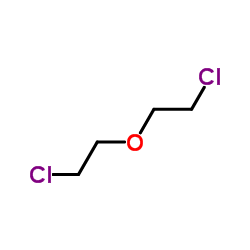Metabolism of bis(2-chloroethyl)ether and bis(2-chloroisopropyl)ether in the rat.
R D Lingg, W H Kaylor, S M Pyle, M M Domino, C C Smith, G F Wolfe
文献索引:Arch. Environ. Contam. Toxicol. 11(2) , 173-83, (1982)
全文:HTML全文
摘要
Male rats were given single peroral doses of bis(1-14C-2-chloroethyl)ether ([1-14C]BCEE) (40 mg/kg) and of bis(1-14C-2-chloroisopropyl)ether ([1-14C]BCIE) (90 mg/kg). Excretion of 14CO2 and urinary 14C was followed for 48 hr. The time required to eliminate one half of the dose was 12 hr for [1-14C]BCEE and 19 hr for [1-14C]BCIE. In the case of [1-14C]BCEE, expired 14CO2 accounted for 11.5 +/- 5.6(SD)% of the dose, urinary 14C accounted for 64.7 +/- 14.8%, and 2.4 +/- 1.3% was found in the feces. The figures for [1-14C]BCIE were 20.3 +/- 9.4% expired as 14CO2, 47.5 +/- 8.1% as urinary 14C, and 3.8 +/- 0.3% as fecal 14C. Thiodiglycolic acid (TDGA) accounted for roughly 75% of the total urinary 14C collected after the [1-14C]BCEE dose. Lesser metabolites of BCEE were 2-chloroethoxyacetic acid (CEAA) (5%), and N-acetyl-S-[2-(2-chloroethoxy)ethyl]-L-cysteine (ACEEC) (7%). Metabolites of [1-14C]BCIE identified in rat urine were 2-(2-chloro-1-methylethoxy)propanoic acid (CMEPA), roughly 36% of the total urinary 14C, and N-acetyl-S-(2-hydroxypropyl)-L-cysteine (AHPC) at 19%.
相关化合物
| 结构式 | 名称/CAS号 | 分子式 | 全部文献 |
|---|---|---|---|
 |
二氯乙基醚
CAS:111-44-4 |
C4H8Cl2O |
|
Carcinogenicity tests of certain environmental and industria...
1981-07-01 [J. Natl. Cancer Inst. 67(1) , 75-88, (1981)] |
|
Thiodiglycolic acid: a major metabolite of bis(2-chloroethyl...
1979-01-01 [Toxicol. Appl. Pharmacol. 47(1) , 23-34, (1979)] |
|
Bis(2-chloroethyl)ether.
1999-01-01 [IARC Monogr. Eval. Carcinog. Risks Hum. 71 Pt 3 , 1265-9, (1999)] |
|
[Medical topics: bischloromethyl ether and lung cancer].
1985-12-01 [Kango. 37(14) , 82, (1985)] |
|
Treatment of persistent organic compounds by integrated adva...
2009-01-01 [Water Res. 43(16) , 3910-21, (2009)] |